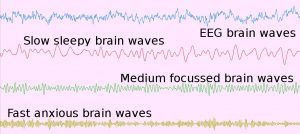What to expect in a training session
When you come into Edinburgh Neurofeedback we immediately make you feel very welcome and at ease. Neurofeedback training is a positive way to help take control of your life and to help address the focus and concentration problems that are holding you back.
Getting started with neurofeedback
If this is your first time with us, your initial neurofeedback assessment will take about 2 hours. During this time we will ask you to explain the problem you want to tackle through neurofeedback training. We also take a full personal and medical history and note down your experiences and frustrations.
The next part of the assessment involves taking a look at your brain waves while you do some simple tasks. You will have sensors placed on your scalp using gel to make a good connection. The brain waves produced by your brain with your eyes open and closed, and also while you read, speak, listen and relax will be recorded. Once the session is over, we use the data and your personal history to devise your neurofeedback training program.
What do brain waves look like?
If displayed on a computer screen, your brain waves can look like curves, spikes or waves. The shapes are produced by the electrical signals picked up by the neurofeedback sensors. These are directly related to your brain activity when you are in different states. So, if you are relaxed, you tend to produce long, slow, curved waves on the screen. If you are anxious or upset, the trace looks very spiky, with the individual spikes quite close together. Daydreaming produces very slow, long waves and focused activity – being ‘in the zone’ – is associated with fast but regular wave activity.
It’s important to remember that these are generalizations. Your brain waves will follow similar patterns but will be individual to you and getting to know your brain waves and what they indicate is one of the most crucial aspects of neurofeedback training.

Neurofeedback sessions
A typical course of neurofeedback training may require 20 individual sessions, each lasting 45 minutes. Some people need more, some don’t need as many; it’s completely flexible. Once in the privacy of the consulting room, sensors will be again attached to your scalp so that your brain waves can be clearly visualized. This is done using a computer screen and you may also play a game, produce patterns or make a DVD play – just using your own brain waves.
The neurofeedback training itself will be closely related to your overall goals. If your primary need is stress reduction, you will focus on relaxing to produce the long, slow brain waves that accompany a calm state. If you want to work on increasing your attention span, your concentration can be improved by using your brain waves to play a game or drive a DVD. Only when you are in highly focused mode will the game play, so this is an excellent neurofeedback technique for children with attention and concentration problems.
Contact Edinburgh Neurofeedback today to find out more about what neurofeedback training could do for you.



Connect With Us